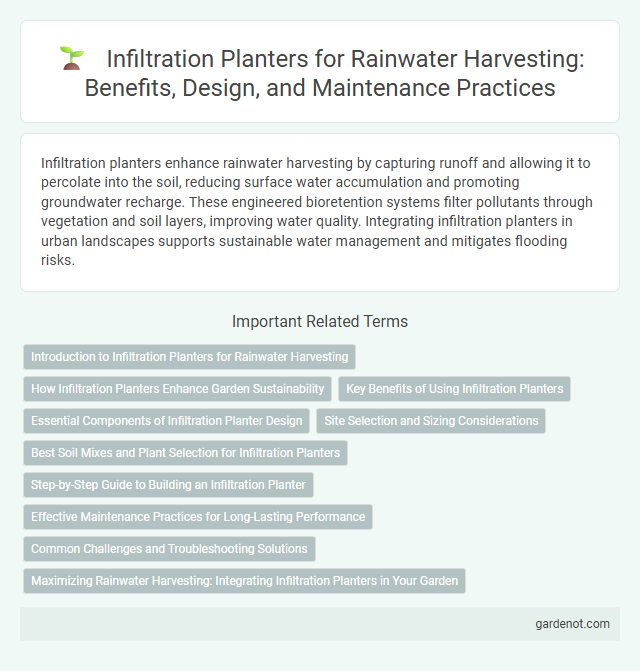Infiltration planters enhance rainwater harvesting by capturing runoff and allowing it to percolate into the soil, reducing surface water accumulation and promoting groundwater recharge. These engineered bioretention systems filter pollutants through vegetation and soil layers, improving water quality. Integrating infiltration planters in urban landscapes supports sustainable water management and mitigates flooding risks.
Introduction to Infiltration Planters for Rainwater Harvesting
Infiltration planters are specialized landscaping features designed to capture and absorb rainwater on-site, reducing runoff and promoting groundwater recharge. These systems integrate vegetation with engineered soil profiles that enhance water infiltration while filtering pollutants. Incorporating infiltration planters in urban rainwater harvesting strategies supports sustainable water management and mitigates flooding risks.
How Infiltration Planters Enhance Garden Sustainability
Infiltration planters enhance garden sustainability by efficiently capturing and filtering rainwater, reducing runoff and soil erosion. These planters promote groundwater recharge through slow infiltration, supporting healthier plant growth and minimizing the need for supplemental irrigation. Their integration reduces urban heat island effects while improving water quality and conserving local water resources.
Key Benefits of Using Infiltration Planters
Infiltration planters effectively manage stormwater by promoting groundwater recharge and reducing surface runoff, which mitigates urban flooding risks. They enhance water quality by filtering pollutants through soil and vegetation, improving the health of local ecosystems. These planters also support urban greenery, contributing to biodiversity and providing cooling effects in heat-prone areas.
Essential Components of Infiltration Planter Design
Infiltration planters rely on essential components such as a porous soil mix, a drainage layer, and an engineered underdrain system to facilitate efficient rainwater capture and infiltration. Incorporating native vegetation enhances pollutant removal while promoting evapotranspiration, reducing runoff volume. Proper sizing and hydrologic soil group assessment ensure optimal infiltration rates and system longevity in rainwater harvesting applications.
Site Selection and Sizing Considerations
Infiltration planter site selection requires assessment of soil permeability, topography, and drainage patterns to ensure effective rainwater absorption and prevent surface runoff. Proper sizing depends on catchment area, rainfall intensity, and planting media capacity to maximize water retention and support vegetation growth. Designing for appropriate depth and surface area promotes optimal infiltration rates and long-term system performance.
Best Soil Mixes and Plant Selection for Infiltration Planters
Infiltration planters perform optimally with soil mixes that balance permeability and nutrient retention, typically combining sandy loam, organic compost, and biochar to enhance water infiltration and support microbial activity. Selecting native, deep-rooted plants such as sedges, rushes, and certain grasses improves water absorption and filtration while ensuring resilience to local climate conditions. Proper soil composition and plant choice are essential for maximizing the efficiency of rainwater harvesting through natural infiltration and pollutant removal.
Step-by-Step Guide to Building an Infiltration Planter
Constructing an infiltration planter begins with selecting a suitable location with moderate slope and well-draining soil to maximize rainwater absorption. Excavate a shallow basin, approximately 12-18 inches deep, incorporate a layered system of gravel and amended soil to enhance infiltration and support vegetation growth. Plant native deep-rooted species to stabilize the soil and filter runoff, then cover the surface with mulch to reduce evaporation and prevent erosion.
Effective Maintenance Practices for Long-Lasting Performance
Effective maintenance practices for infiltration planters involve regular removal of debris and sediment to prevent clogging and ensure optimal water absorption. Periodic inspection of vegetation health and soil condition supports sustained filtration and promotes plant growth essential for pollutant removal. Implementing these maintenance routines enhances infiltration rate, extends system lifespan, and maintains the performance of rainwater harvesting infrastructure.
Common Challenges and Troubleshooting Solutions
Infiltration planters often face challenges such as soil compaction, poor drainage, and sediment buildup, which can reduce their effectiveness in capturing and filtering rainwater. Solutions include regular soil aeration, installing underdrain systems, and implementing sediment traps or pre-filters to maintain infiltration capacity. Monitoring plant health and selecting drought-tolerant, native vegetation also improves system resilience and performance over time.
Maximizing Rainwater Harvesting: Integrating Infiltration Planters in Your Garden
Infiltration planters enhance rainwater harvesting by capturing and slowly releasing stormwater into the soil, reducing runoff and promoting groundwater recharge. These planters use engineered soil media and native plants to increase infiltration rates, support local biodiversity, and improve garden resilience during dry periods. Installing infiltration planters strategically in your garden maximizes water conservation while mitigating urban flooding risks.
Infiltration planter Infographic

 gardenot.com
gardenot.com